
Montagnana is a town and comune in the province of Padova, in Veneto. Neighbouring communes are Borgo Veneto, Casale di Scodosia, Urbana, Bevilacqua, Pojana Maggiore, Pressana, Minerbe and Roveredo di Guà. As of 2017, the population of Montagnana is 9120. The town was awarded with the Bandiera arancione and is one of I Borghi più belli d'Italia.
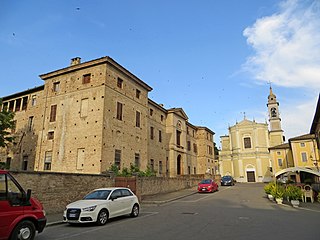
Soragna is a town and comune in the province of Parma of northern Italy with a population of about 4,800.

The Rocca Sanvitale, or Sanvitale Castle, is a fortress residence in the centre of the town of Fontanellato, near Parma, northern Italy. Construction of the moated block, accessible through a drawbridge, was begun in the 13th century, mostly completed by the 15th century, with embellishments continuing through to the 18th century. It is prototypical of the urban castle-houses of the turbulent medieval communes of Northern Italy. Until the 1930s it was the home of the descendants of the Count of Sanvitale.

Roccabianca is a comune (municipality) in the Province of Parma in the Italian region Emilia-Romagna, located about 110 kilometres (68 mi) northwest of Bologna and about 25 kilometres (16 mi) northwest of Parma.
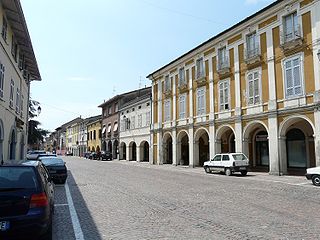
San Secondo Parmense is a comune (municipality) in the Province of Parma in the Italian region Emilia-Romagna, located about 200 kilometres (120 mi) northwest of Bologna and about 15 kilometres (9 mi) northwest of Parma.
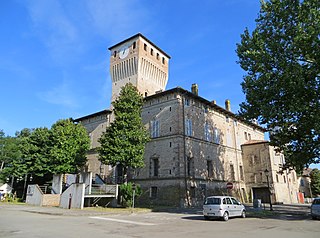
Sissa is a town in the Italian region of Emilia-Romagna. Administratively, it is a frazione of the comune of Sissa Trecasali in the Province of Parma. It was an independent comune until it was merged in 2014 with Trecasali to form Sissa Trecasali. It is located about 100 kilometres (62 mi) northwest of Bologna and about 20 kilometres (12 mi) northwest of Parma.

Torrechiara Castle is a 15th-century castle near Langhirano, in the province of Parma, northern Italy. It sits atop a terraced hill south of the city of Parma, in a strategic position overlooking the Parma River in the valley below. The castle was commissioned by Pier Maria II de' Rossi, the fourth count of San Secondo, and built between 1448 and 1460. The fortress shows the influence of the castles of the House of Sforza, particularly Visconti-Sforza Castle. The castle is managed by the Polo Museale dell'Emilia Romagna since 2015.
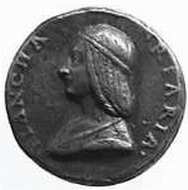
Bianca Riario was an Italian noblewoman and regent, Marchioness of San Secondo by marriage to Troilo I de' Rossi, and regent of the marquisate and county of San Secondo for her son Pier Maria during his minority between 1521 and 1522. She was the eldest child and only daughter of Caterina Sforza by the latter's first husband, Girolamo Riario, a nephew of Pope Sixtus IV.

The Torre del Gallo is a historical building located in Florence, Italy, located at Pian de' Giullari, in the hills of Arcetri, on top of a ridge overlooking the city where there is a magnificent panorama.

San Giovanni Evangelista is a Mannerist-style, Roman Catholic church located on Piazzale San Giovanni, located just behind the apse of the Parma Cathedral, in the historic center of Parma, northern Italy. The buildings surrounding the piazza were also part of a former Benedictine convent. The church is notable for its Correggio frescoes.

The Palio di Parma is a festival that is held once a year in the northern Italian town of Parma, and traces back to the ancient "Scarlet Run". The Palio is normally hold on the third weekend of September.
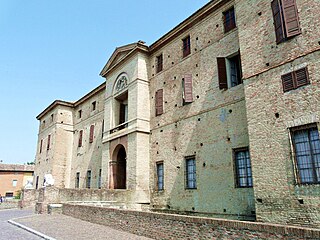
The Rocca Meli Lupi, also called Rocca di Soragna, is a castle-palace located in the town of Soragna, Province of Parma, region of Emilia-Romagna, northern Italy. It has a rough, unfinished exteriors and highly decorated interior rooms.

The Castello or Castle of Roccabianca, also called Rocca dei Rossi, is a castle built in the town of Roccabianca, province of Parma, Emilia Romagna, northern Italy.

Pier Maria Rossi or Pier Maria II de' Rossi was an Italian condottiere and count of a region around present San Secondo Parmense. His properties included the castle of Rocca dei Rossi. He was known as "the Magnificent".
Troilo I de' Rossi was an Italian condottiero and the first marquess of San Secondo.
Giovanni de' Rossi was an Italian condottiero and the fifth count of San Secondo. He was nicknamed 'il diseredato'.
Guido de' Rossi was an Italian condottiero.
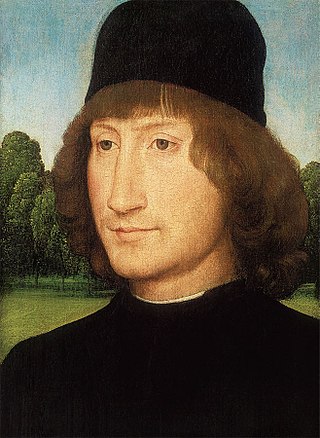
Sforza Secondo Sforza was an Italian condottiero.

The Rocca Sanvitale or Sanvitale Castle of Sala Baganza is a fortress/palatial residence located on Piazza Gramsci #1, overlooking the small town of Sala Baganza, just southwest of Parma, region of Emilia-Romagna, Italy. It is distinct from the more-visited moated castle of Rocca Sanvitale, Fontanellato.

The Rossi family is an Italian noble lineage originating from the Emilia region, now part of the province of Parma. Their history is well-documented in the archives of Parma and San Secondo. The earliest recorded mention of the Rossi family in Emilia dates back to 1323.

















